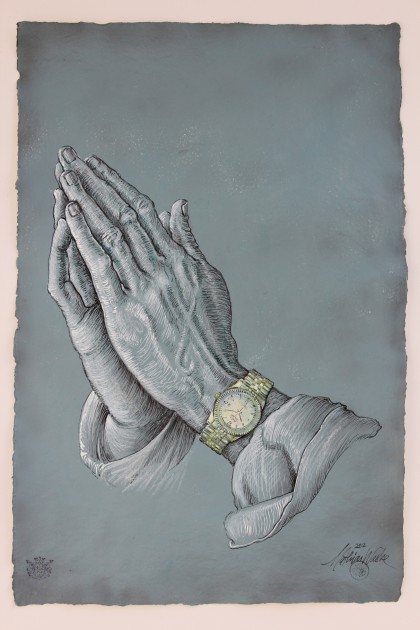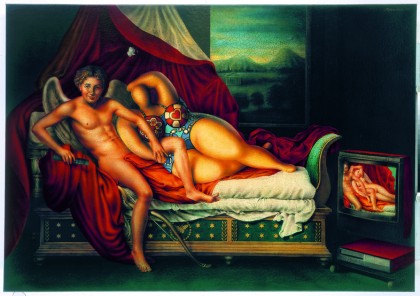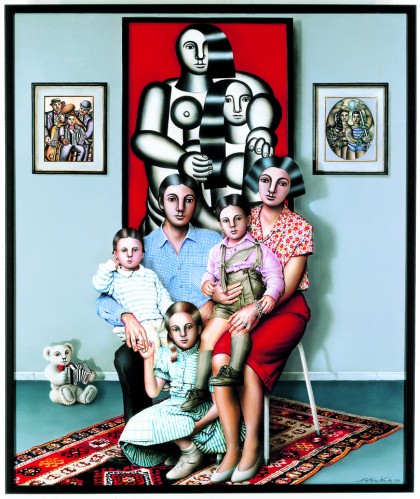
22 Jun Mathias Waske: To Laugh is an Art
By David McKenzie
Although he skirts the common techniques of the Modern Art canon, Mathias Waske’s body of work has distinguished him as an important contemporary artist. His techniques often remind of the Old Masters and Renaissance painters, with a masterful control of traditional perspective and colour; but his images are strikingly current, playfully provocative and undoubtedly modern.
Born in the town of Crailsheim in Germany’s Baden-Württemberg region, Mathias Waske grew up surrounded by the vibrant, chaotic, resurgent atmosphere of post-war, American-controlled Frankfurt am Main. After graduating from the city’s State University for Fine Arts in 1967, Waske had his traditional technique honed by inspirational visits to Florence and Venice, coming into contact with works from the high point of the Italian Renaissance. Since 1968 he has been living and working between Munich and the South of France, but his popularity and artworks have spread all over the world.
The intricate precision and attention to detail of Waske’s paintings allow them to be not just aesthetically pleasing but also intellectually engaging. The swathe of issues raised and explored by his stimulating works are contemporary ones: our obsession with icons (be they historical heroes, social figures, or a ubiquitous automobile), our debilitating comfort in familiarity, the unifying or dividing power of cultural symbols and mass production, the farce of politics, our ambiguous relationship with a collective past, and irrational social conventions unthinkingly accepted as the norm – to name just a few.
But the way Waske invites the audience to ponder such contemporary issues is a mixture of old and new. A skilful harmony between compatible colours and expert control of shading and perspective make immediate impressions of Old Master techniques rather than modern ones. But that is just the platform that allows Waske’s work to be so communicable – these realistic depictions induce the audience to notice their paradox with the works’ subject-matter.
The style and content are often at odds with one another. This makes ideas leap out of Waske’s paintings. He frequently invokes the use of well-known motifs and cliches, juxtaposed with farcical, comical subjects. From the ancient Greek Discobolus of Myron to the Mona Lisa, Vincent van Gogh and Pablo Picasso, he takes snippets of beloved artworks and deprives them of their original context and intention, creating an entirely new means of interpretation.
Waske’s work maintains a light-hearted tone, and his comical, bizarre combinations often make laughter the first response to his works. However, after this initial reaction, deeper contemplations arise. Why do we find such things amusing, what is it about our connection to the ideas, icons or images of the painting that leave room for Waske to play around with our association with those? Waske’s work in effect caricatures much of what people unquestioningly take for granted – the normal and accepted, even if accepted only through convention. It is a collection of parodies of things we know in everyday life. They may be trivial elements, or supposedly serious concerns, but Waske’s work challenges our ability to separate the two.
Mathias Waske’s unique style, founded in expert artistic technique but fuelled by prescient social and cultural relevancy, has long established him as a leading contemporary artist and primary exponent of Modern Realism. This recognition has been accompanied by numerous prestigious international awards, and in 2012 he was bestowed the title of Summa cum Laude, the highest possible honour from the Kunsthof Schloss Reinharz Circle of Masters. His work has graced exhibitions, private collections and permanent gallery collections across the world. The pensive scope of Waske’s work and its ability to resonate with viewers from all walks of life is reflected in the long list of prominent people who have admired Waske’s work enough to include it in their private collections – including former German president Walter Scheel, former Pope John Paul II, the Royal House of Monaco and even the astronauts from the successful Apollo 11 mission.
In Mathias Waske we have a precious artistic talent. One with the potential to inspire, intrigue, shock, or, above all, make us laugh, that most ubiquitous and beautiful of human responses.
“The intricate precision and attention to detail of Waske’s paintings allow them to be not just aesthetically pleasing but also intellectually engaging.”
“A skilful harmony between compatible colours and expert control of shading and perspective make immediate impressions of Old Master techniques rather than modern ones.”
“From the ancient Greek Discobolus of Myron to the Mona Lisa, Vincent van Gogh and Pablo Picasso, he takes snippets of beloved artworks and deprives them of their original context and intention, creating an entirely new means of interpretation.”
“Waske’s work in effect caricatures much of what people unquestioningly take for granted – the normal and accepted, even if accepted only through convention.”






